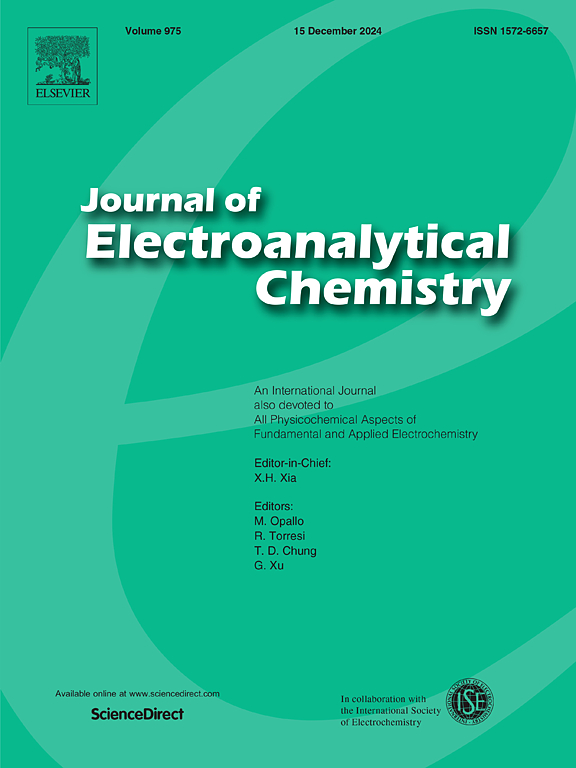Highly dispersed ZIF-67-derived co-NC confined in carbon pores enables efficient oxygen reduction in alkaline media
IF 4.1
3区 化学
Q1 CHEMISTRY, ANALYTICAL
引用次数: 0
Abstract
It is crucial to develop low-cost and efficient electrocatalysts to facilitate oxygen reduction reaction (ORR) and transition metals incorporated into nitrogen-doped carbon matrices (M-NC) catalysts are regarded as a potential candidate to substitute platinum-based electrocatalyst. However, there is still a great challenge in real activity and stability, compared to Pt-based electrocatalysts, for large-scale applications. An effective way to improve the ORR performance for this category of single-atom catalysts is to increase the density of active sites. In this work, therefore, the highly dispersed ZIF-67-derived Co-NC confined in carbon pores electrocatalysts are synthesized by impregnating ZIF-67 precursors into the nanopores of Ketjenblack EC-600JD (KB) resulting in the in-situ growing of small crystals in the pores followed by the high temperature pyrolysis. The as-prepared CoNC-700@C electrocatalyst exhibits excellent ORR performance in alkaline media with an onset potential of 967 mV and a half-wave potential of 892 mV (vs. RHE), which is much higher than that of the commercial Pt/C catalyst. It is inferred that the excellent ORR activity of CoNC-700@C mainly results from the increased density and also enhanced dispersion of active sites due to the confinement effect offered by the pores of KB. This study also provides a simple and effective method to increase the density of active sites for single-atom category materials.

高度分散的zif -67衍生的co-NC被限制在碳孔中,可以在碱性介质中有效地还原氧气
开发低成本、高效的电催化剂促进氧还原反应(ORR)至关重要,过渡金属掺杂到氮掺杂碳基体(M-NC)催化剂中被认为是替代铂基电催化剂的潜在候选材料。然而,与基于pt的电催化剂相比,大规模应用的实际活性和稳定性仍然存在很大的挑战。提高这类单原子催化剂的ORR性能的有效途径是增加活性位点的密度。因此,通过将ZIF-67前驱体浸渍到Ketjenblack EC-600JD (KB)的纳米孔中,在孔中原位生长小晶体,然后进行高温热解,合成了高度分散的ZIF-67衍生的Co-NC。制备的CoNC-700@C电催化剂在碱性介质中表现出优异的ORR性能,起始电位为967 mV,半波电位为892 mV(相对于RHE),远高于商用Pt/C催化剂。由此推断CoNC-700@C优异的ORR活性主要是由于KB孔隙的约束作用增加了活性位点的密度,也增强了活性位点的分散。本研究也为提高单原子类材料活性位点密度提供了一种简单有效的方法。
本文章由计算机程序翻译,如有差异,请以英文原文为准。
求助全文
约1分钟内获得全文
求助全文
来源期刊
CiteScore
7.80
自引率
6.70%
发文量
912
审稿时长
2.4 months
期刊介绍:
The Journal of Electroanalytical Chemistry is the foremost international journal devoted to the interdisciplinary subject of electrochemistry in all its aspects, theoretical as well as applied.
Electrochemistry is a wide ranging area that is in a state of continuous evolution. Rather than compiling a long list of topics covered by the Journal, the editors would like to draw particular attention to the key issues of novelty, topicality and quality. Papers should present new and interesting electrochemical science in a way that is accessible to the reader. The presentation and discussion should be at a level that is consistent with the international status of the Journal. Reports describing the application of well-established techniques to problems that are essentially technical will not be accepted. Similarly, papers that report observations but fail to provide adequate interpretation will be rejected by the Editors. Papers dealing with technical electrochemistry should be submitted to other specialist journals unless the authors can show that their work provides substantially new insights into electrochemical processes.

 求助内容:
求助内容: 应助结果提醒方式:
应助结果提醒方式:


